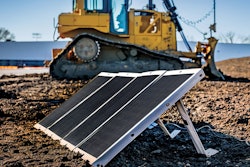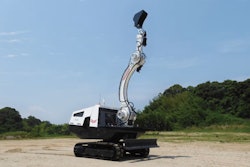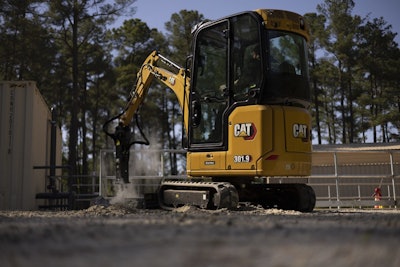
Caterpillar’s 9,600 square-foot exhibit at CES 2024 will focus on the manufacturer’s electric machines and energy solutions.
At the heart of the CES 2024 exhibit will be the battery-powered Cat R1700 XE LHD underground loader and a 301.9 electric compact excavator.
The loader has a 16.5-ton payload and reaches a top speed of 11.2 mph. According to Cat, the battery charges in less than 20 minutes when paired with two of the mobile Cat MEC500 chargers.
Cat’s compact electric excavator is powered by a Cat 48 volt, 32kWh battery with an approximate runtime of up to 8 hours. It has an onboard AC charger for overnight charging, and there also is a DC fast-charging option.
Also being displayed at CES will be a Cat 750V electric motor and inverter, components that support a variety of machines and power systems.
For more details on each of the displayed equipment and Cat's approach to alternative power for construction equipment, read on:
Showing the Latest Alternative-Energy Solutions
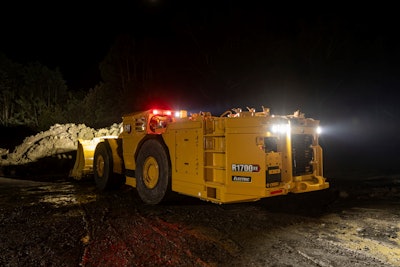 A highlight of Cat's CES 2024 exhibit will be the R1700 XE electric loader.Caterpillar
A highlight of Cat's CES 2024 exhibit will be the R1700 XE electric loader.Caterpillar
“We're learning, and we want to learn with our customers,” said Mitch Tobias, Caterpillar Construction Industries strategy and planning manager. “There's things that customers can do today, and there's things that we're working on for tomorrow that's going to bring benefits as that comes.”
Ultimately, it all comes down to the common quandary for a contractor of choosing the right size machine for the job that will still help save fuel costs and maybe reduce greenhouse gas emissions.
Cat says it has been developing products focused on productivity, performance, and efficiency.
"Sustainability also has been a very important category for Caterpillar for several years," said Mitch Tobias, Caterpillar's strategy and planning manager. "We've really made that part of our daily DNA as we've been developing our products and how we're bringing those to market."
One of the reasons for that is the company knows that burning fuel just for the sake of burning fuel isn't necessarily the right thing to do.
"Not only is it good for business, but it's also good for sustainability. One of the best ways to not have emissions is to not burn excess fuel," Tobias said.
Since 2011, Cat has published a sustainability report, leading the concept to be elevated to be the company’s fourth area of focus in its enterprise strategy.
“Caterpillar is going to continue to expand options so customers can choose their machine choose their power for today and tomorrow,” said Connie LaFlamme, Cat Global Sustainability Marketing market professional.
Compared to previous generations of machines, Cat's current offerings have between 10% to 20% reduced fuel burn and associated greenhouse gas emissions. In addition, more of the machines have telematics systems to manage and monitor fuel burn.
The ability to monitor each part of the ecosystem of the machine allows the company to provide advanced analytics, transforming data into customer insights making it easier for customers to own and operate their equipment.
“We have a lot of technology built into our machines,” LaFlamme said. “If you follow our tips on managing idle time, it's a large component of a machine’s day-to-day life.”
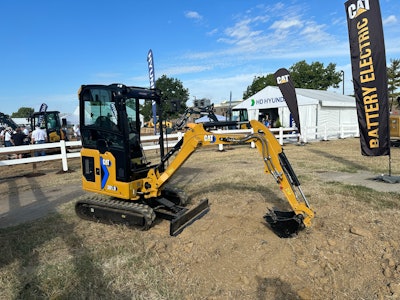 The 301.9 Electric mini excavator is powered by a Cat 48 volt, 32kWh battery with an approximate runtime of up to 8 hours based on average to moderate application use.Equipment World
The 301.9 Electric mini excavator is powered by a Cat 48 volt, 32kWh battery with an approximate runtime of up to 8 hours based on average to moderate application use.Equipment World
The Cat experience
At the heart of the CES 2024 exhibit will be the battery-powered Cat R1700 XE LHD underground loader and a 301.9 electric compact excavator.
The loader has a 16.5-ton payload and reaches a top speed of 11.2 mph. According to Cat, the battery charges in less than 20 minutes when paired with two of the mobile Cat MEC500 chargers.
Cat’s compact electric excavator was first unveiled at Bauma 2022 as one of four prototype electric machines. Contractors had an opportunity to operate the 301.9 at Utility Expo. (Watch for an upcoming story on the model).
The company says the 301.9 Electric mini excavator is powered by a Cat 48 volt, 32kWh battery with an approximate runtime of up to 8 hours based on average to moderate application use. It has an onboard AC charger for overnight charging and there also is a DC fast-charging option.
“Our customer base is incredibly diverse, the markets, industries that we serve, there isn't a one size fits all solution when it comes to our battery offerings,” said Dustin Childers, Caterpillar Industrial Power Systems Division global marketing manager.
One of the things that Cat is doing is exploring the different chemistry options that are available to determine the right battery solution while ensuring that those battery solution offerings are modular and scalable in nature for customers. That will help create consistency for the diverse fleets of equipment and industry uses.
Childers noted that the durability of the battery packs also must be considered, based on the harsh conditions most of Cat’s customers work in. Other critical pieces include the electronic components, the telematics, or digital service pieces which provide customers a viable solution to monitor and manage the battery systems.
 Caterpillar
Caterpillar
Plugged in
A component of the energy transition journey is the assurance that some kind of charging infrastructure is in place. Cat will be featuring its lineup of charging solutions at CES, like the products displayed at ConExpo 2023.
“One of the things that we want people to take away is that we are taking an approach as Caterpillar that as we release these battery electric machines to the market, we are going to provide our customers the same compatible charging solutions that they'll need for those machines at the time that the machines are released," said John Thomas, product application specialist Cat Electric Power Division. “We don't intend to leave that to our customers to go figure out on their own.”
Charging options for the electric models include the Cat MEC500 Mobile Equipment Charger and the XEX60 compact energy storage solution or ESS.
“We have what we call a compact ESS or energy storage solution, basically think of it as a battery in a box,” Thomas said, referring to the XEX60.
The ESS units can be used with any combination of diesel, natural gas, or renewable energy sources such as solar or wind. It is not powered by the grid it's charged from power generated onsite.
At ConExpo 2023, Cat displayed an ESS using solar panels to charge as an example of how a contractor could utilize the system at a site where there is no grid or utility connection.
That unit, the XEX60, a compact ESS, can be used in a couple of different ways. It can be set up with solar onsite or some other onsite power sources in the future such as hydrogen fuel cells or it can be taken back and forth on and offsite like a diesel storage tank.
"If you think of it as kind of an electric portable storage tank and so it can be taken off-site, charged or recharged and then taken back to the site which is connected to the machine as a charging power source," Thomas said.
Also being displayed at CES will be a Cat 750V electric motor and inverter, components that support a variety of machines and power systems. A 750 DC motor provides mechanical power for the machine's movement when commanded by the operator. The inverter transfers power to the electric motor from an onboard Cat machine power source like a generator or battery.

Future fuels
Dating back to the 1980s, Cat has been working with hydrogen and other lower carbon-intensity fuels.
“The beauty of Caterpillar is that we like to share that information internally,” Tobias said. “The things that we start to learn about in a stationary power source we can also look to how we can apply that in mobile applications and bring those to customers where it makes sense.”
He said Cat continues to work with customers to determine what solutions make sense for what applications, as well as what fuels. There is recognition that some customers may have easier access to a power grid, while others will have easier access to hydrogen.
Additional fuel options Cat is working with include 100% hydrotreated vegetable oil (HVO), B100 distilled biodiesel, and B100 standard biodiesel. Some of these are drop-in-ready options today without any retrofitting required.
As an example, the HVO itself does not reduce tailpipe emissions. However, over the lifecycle of a machine, in terms of sustainability, it is potentially better, according to Cat.
“Those are some of those things that we're here to help customers understand and educate them about," Childers said.
Many contractors will step up and make the argument for reduced fuel emissions, however, those same customers are not necessarily educated about their varied fuel options.
"Many people are not familiar with current offerings that exist and how the different fuel types may work in equipment and how different reman service offerings help sustainability," Thomas said. “I think it's a really big opportunity for our customers to get more understanding and educated about what it means to be sustainable.”
Recently, Cat announced the launch of a hydrogen-hybrid project featuring the Cat 13D engine. Development of the project is slated to get underway in the first quarter of 2024.
Unveiled at ConExpo 2023 the Cat C13D platform supports a variety of renewable fuel options in addition to hydrogen and natural gas.
Slow change
"I think as you hear a lot of people talking about this energy transition it's not something that someone's going to walk in and decide we're going to flip the switch and everything's going to go to a different power source,” Tobias said. “There's a good reason that diesel fuel is an extremely dense power source, which is why it’s used in so many applications.”
He said diesel will be around for a while and as far as an energy transition goes, it will be a journey for both manufacturers and contractors as each transition through different types of products and technology.
“That's why you see us doing the things that we're doing with these products, to enable us to bring the product that makes the most sense at the right time and in the right part of the journey that our customers are on,” Tobias said.


